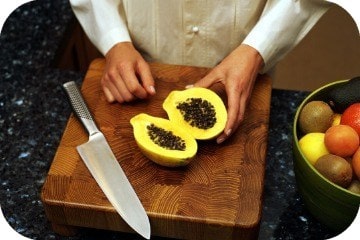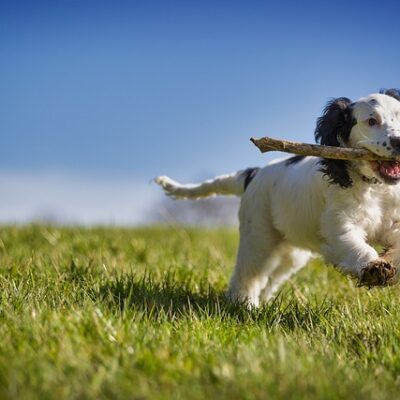Can dogs eat papaya? Yes, but make sure you remove the pips and peel. When given to your dog in moderation, papaya offers a variety of nutritional benefits, and the enzymes are excellent for promoting a healthy gut in dogs and humans. Papaya is especially high in fiber along with other vitamins and minerals such as; magnesium, potassium, and vitamin C.
This article will provide you with the health benefits and concerns of papaya. It will also provide detailed information regarding other healthy fruits as well as activities and games to help make fruit feeding fun and enjoyable.
Busy? Get Your Hands Paws On The Answers Quickly…
- Can Dogs Have Papaya?
- Preparing And Serving Papaya
- Other Healthy Fruits Dogs Can Eat
- Fun Fruit Games For Dogs
- FAQs
CAN DOGS HAVE PAPAYA?
Yes, as mentioned above, dogs can have papaya in moderation. As with all human foods, dogs shouldn’t have too much as it can cause an upset stomach. Papaya works well as treats or to use in fun and stimulating activities. Below we have outlined the health benefits and concerns for when it comes to dogs eating papaya.
Health Benefits
Fiber
Fiber isn’t a necessity in a dog’s diet and isn’t something ‘wild’ dogs would have eaten. However, it can help with the gut, digestive system, and to keep consistent bowel movements.
Magnesium
Magnesium is another vital mineral for dogs. Magnesium helps the dog’s body to process as well as functioning the nerve system and muscle mobilization. If you notice a change in your dogs’ muscle strength or tone, this could be down to a lack of magnesium. Foods that have high levels of magnesium include; tofu, whole grains, fish, and nuts.
Potassium
High levels of potassium can be provided from papaya. Potassium is an excellent nutrient for your dogs as it helps to control their nerve impulses, functions the brain, muscle activity, and function of the heart. If your dogs’ potassium levels become too low, it can cause hypokalaemia. Hypokalaemia can affect some dogs a lot, while others won’t show any symptoms. The lack of potassium can affect a dog’s neurological, skeletal, and cardiac muscles, and if left untreated, it could be fatal.
Vitamin A
Papaya helps provide your dog with vitamin A. Vitamin A is vital for your dog as it helps to improve and maintain their optimal health. Vitamin A also helps to keep your dogs skin, coat muscles, and nerves in working order; without this vital vitamin, dogs will become lethargic and seriously ill. Other foods high in vitamin A include; carrots, spinach, pumpkin, and sweet potatoes.
Health Concerns
Allergic Reaction
As with all new foods, dogs may be allergic to papaya. If your dog is trying papaya for the first time, ensure it is of a small quantity. Once swallowed and digested, it may be a good idea to keep a close eye on your dog’s behavior shortly after, as they may show signs of an allergic reaction.
Symptoms of an allergic reaction
> Vomiting
> Swollen & Red Lips
> Diarrhea
> Loss of Appetite
> Lethargic When Moving
> Seizures
If your dog is showing any of these symptoms, call your veterinarian straight away to find out the procedures that follow.
Seeds
The seeds of papaya may carry harmful and toxic bacteria or parasites. It is always vital that the seeds are removed before serving as they also pose a choking hazard to dogs. As well as this, the seeds are also very difficult for dogs to digest and may stay whole inside a dog’s stomach for a long period.
Peel
It is always recommended to remove the peel before feeding papaya to a dog. The roughness of the peel makes it very difficult for dogs to digest, and quite frankly, it doesn’t taste as good as the juicy, soft fruit inside!
PREPARING AND SERVING PAPAYA
Peel
Before feeding the papaya to your pup, you should remove the peel from the outside. As previously mentioned, this can carry bacteria that can be transferred to your dog. Also, due to its rough texture, it can be very hard for your dog to swallow and digest.
Remove Seeds
It is very important to remove the seeds of the papaya fruit. Not only do they pose a choking hazard to your dog, but they can also be toxic.
Slice and Dice
Finally, ensure the papaya is finely chopped. Chopping it into chunks, approximately 2cm x 2cm, allows your pup to easily chew, swallow, and digest the fruit.
OTHER HEALTHY FRUITS DOGS CAN EAT
Apple
Apples contain high levels of vitamins A and C. These are delicious and refreshing snacks for your dogs. When frozen, apples are excellent for a dog’s teeth.
Rather than chewing away at a bone or stick, a frozen apple works as well, if not better. As well as this, it also helps to remove any residue of a dog’s teeth, resulting in a better smelling breath!
Figs
Not many humans, let alone dogs eat figs, but in fact, they’re a highly nutritious fruit, full of flavor and extra juicy! Figs are nutritionally known for their high levels of potassium. Potassium has been shown to reduce blood pressure levels in dogs.
This fruit is also excellent for those dogs that are on a weight loss regime. They are low in calories yet super filling, meaning your dog may not be pestering you for more food once you’ve given them some fig.
Guava
As with all ‘human’ foods, dogs should be given guava in moderation. Guava is highly nutritious and provides dogs with beneficial vitamins and minerals, including; fiber, vitamin A &, potassium, and magnesium.
However, guava is also high in carbohydrates and sugars. Therefore it should only be given as a small treat.
Kiwis
Kiwi’s make an excellent snack for your dog. If feeding kiwi to your dog, it is best to remove the skin before doing so as it can be difficult to digest. Kiwis provide your dog with high levels of vitamin C and potassium, which are important nutrients within their diet. Kiwi’s may seem a small fruit for us humans, but a whole kiwi could be too much for a dog. Prepare the kiwi by slicing it into small chunks and feeding around ¼ or ⅓ of the kiwi at a time.
As with all ‘human’ foods, when introducing it into your dog’s diet for the first time, it is recommended that you contact your local vet for serving suggestions.
FUN FRUIT GAMES FOR DOGS
It can be quite easy to chop up the fruit and chuck it into your dog’s bowl to eat. Why not make them work for it? Struggling for ideas on how to? Below we have described and linked some ways that will challenge your dogs and make them work for their fruit. There are plenty of benefits of enrichment games for not just your dog, but also you as the owner too.
Benefits Of Canine Enrichment Games:
> Tires your dog out – A tired dog tends to be easier to train and better behaved
> Increase brain capacity – Playing brain games keeps your dogs brain sharp
> Rewarding for your dog – Being rewarded with treats or toys is great for dogs, it keeps them happy and mentally healthy
> Lowers stress and anxiety – Increasing physical and mental exercise is excellent for improving mental stress for your dog
> Increases the bond between you and your dog – Introducing new and fun games is exciting and your dog, by helping and playing these games with your dog, you will improve and build your relationship
We love finding games our dogs enjoy, and they’re perfect when you can only do a short walk or as an additional enrichment activity.
This is a great one for dogs who have never done enrichment before.
It’s the cheapest and easiest of our enrichment activities. You can use any vegetables suitable for dogs. Our favorites are cucumber, bananas, apples, carrots, and zucchini.
Read below for some excellent enrichment games for you and your dog!
Kong Stuffing
Kong stuffing is pretty simple. If you’ve not heard of a kong before, have a look at one here. They are designed with a soft outside with a hollow inside. The inside can be stuffed with different types of food; the aim is for your dog to lick or nibble the food from the inside of the kong.
If you would like to read more about the kong and kong recipes, read our article “Kong Stuffing Recipes.”
Fruit String Game
The vegetable string game is brilliant for your dog. It is very cheap, basic and I can almost guarantee you’ve got the equipment already at home.
In short, the string game consists of a piece of string approximately 1 meter long with various fruit and vegetables threaded on to it (a bit like a string kebab). Either end of the string is then tied around something. Your dog is to try and nibble the fruit or vegetables of the string. Quick, easy, and cheap.
Read our article “String Vegetable Game For Dogs” to find out more and a step-by-step guide on what to do.
Muffin Tray Freeze
The muffin tray freeze is what you see in the photo above. It is very very simple yet provided our retriever with 45mins-1hour of fun. Simply put some highly nutritious fruit and vegetables in a muffin tray, top with water and place in the freezer. For more information on this activity, read our article “Frozen Muffin Tin Game“.
Fruit Water Bobbing
Another simple yet enriching game for your dog. All you will need is a tub or bucket of water, sliced fruit, and your dog. The aim is for your dog to fetch out the fruit from the water using their teeth, sounds simple, but it can be a little tricky for your dog.
You can read more about this activity as well as six others in our article “7 Easy, Cheap And Homemade Enrichment Games And Activities For Dogs“, enjoy!
What is the best time to eat papaya?
The best time to eat papaya tends to be early morning (breakfast).
What fruit is bad for dogs?
It is best for dogs to stay clear of cherries, grapes, and raisins. These fruits are highly toxic to dogs and can cause serious harm or even death.
What is the best fruit for kidney?
Blueberries. They contain an antioxidant called anthocyanins, which can help people and animals defend specific illnesses and diseases such as cancer, heart disease, cognitive decline, and diabetes.
Looking for more pawsome posts? Check these out…
Can Dogs Eat Lettuce?
How To Make A Snuffle Mat
When Do Puppies Lose Their Teeth?
Can Dogs Eat Broccoli?
Can Dogs Eat Watermelon?
Disclaimer: Each dog is different, and every circumstance is different. All efforts have been made to provide accurate information. However, it is not provided by a qualified Veterinarian, Veterinarian Surgeon, or Behaviorist. The information provided is purely educational. The information should not be used as an alternative or substitute for medical care. If you have any health or medical concerns, contact a qualified Veterinary Surgeon or Veterinarian immediately.











No Comment! Be the first one.